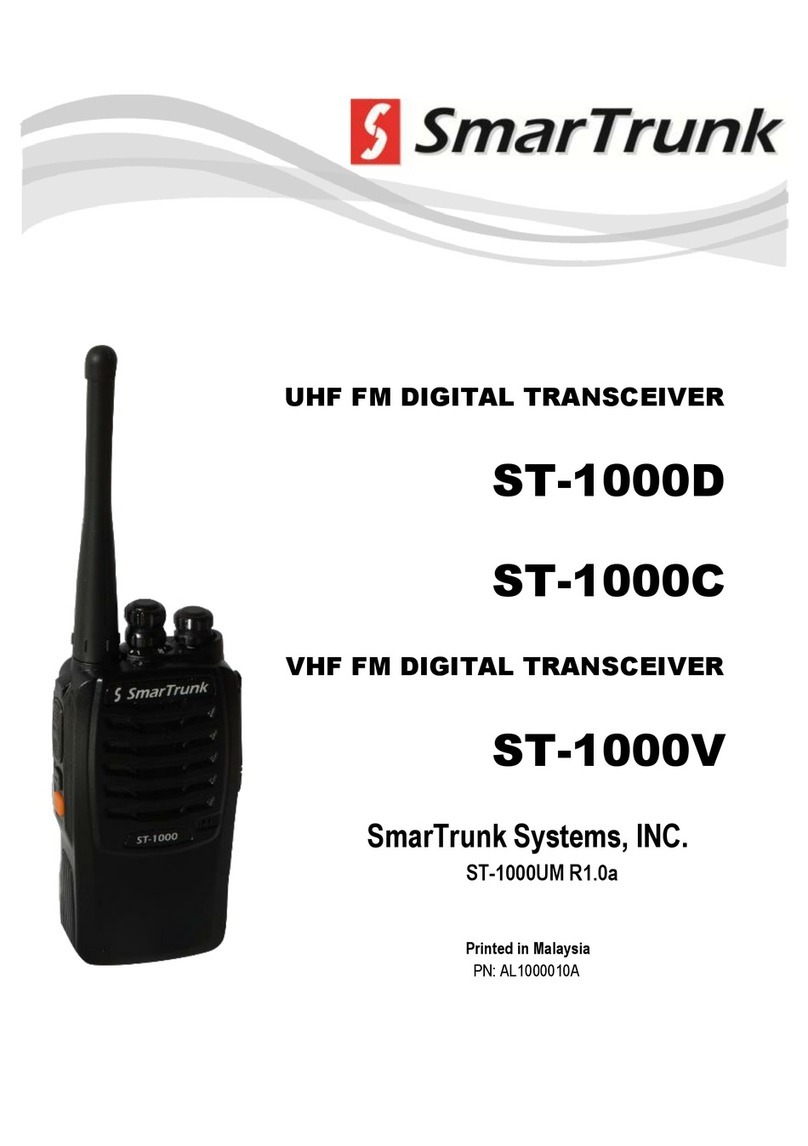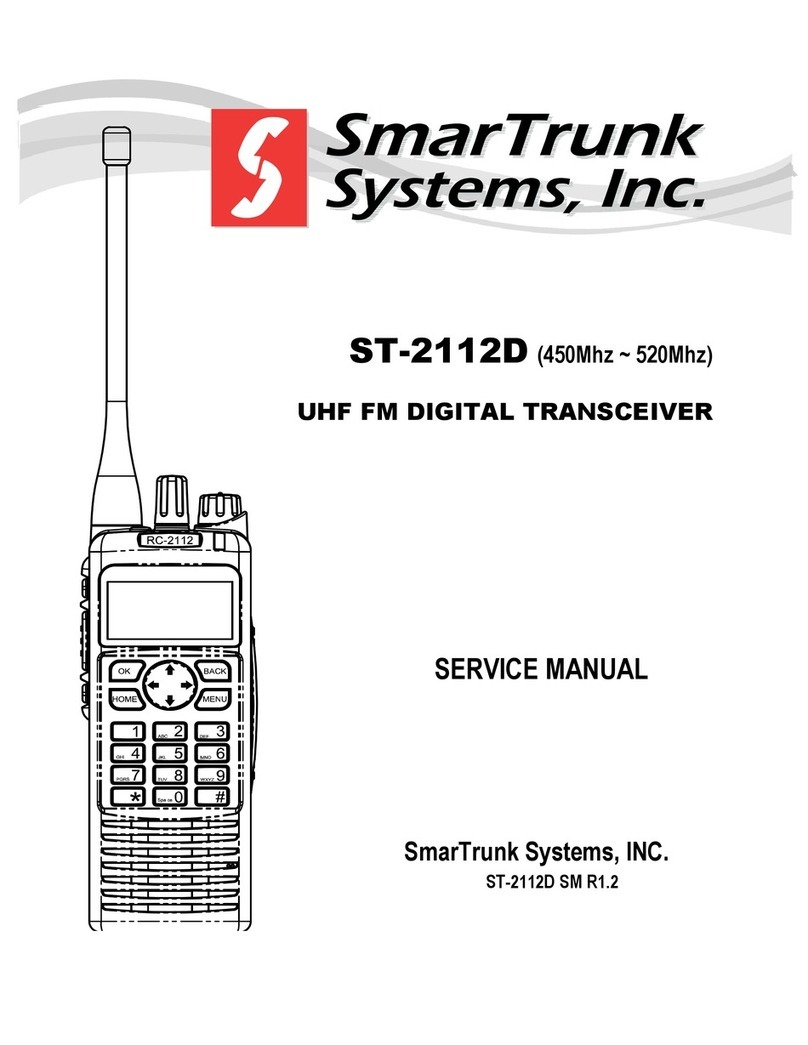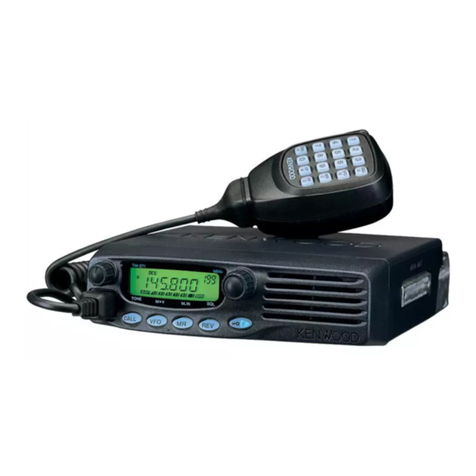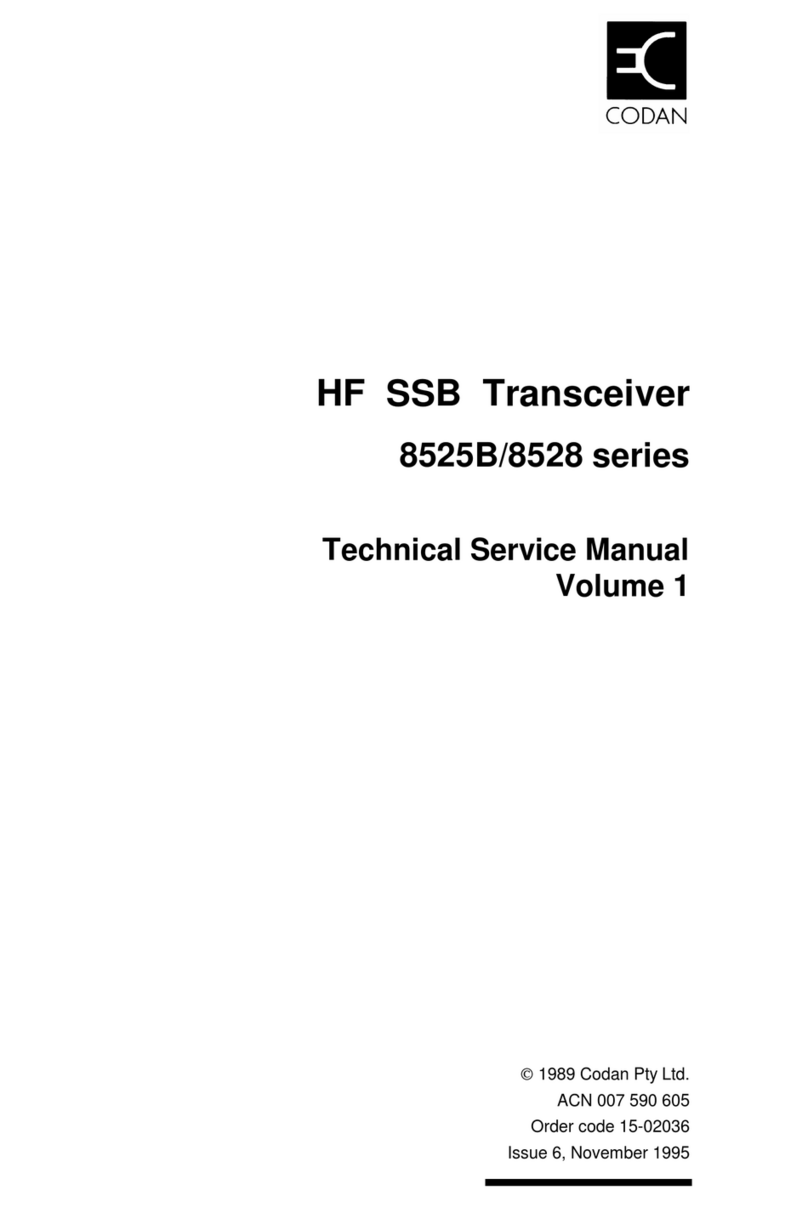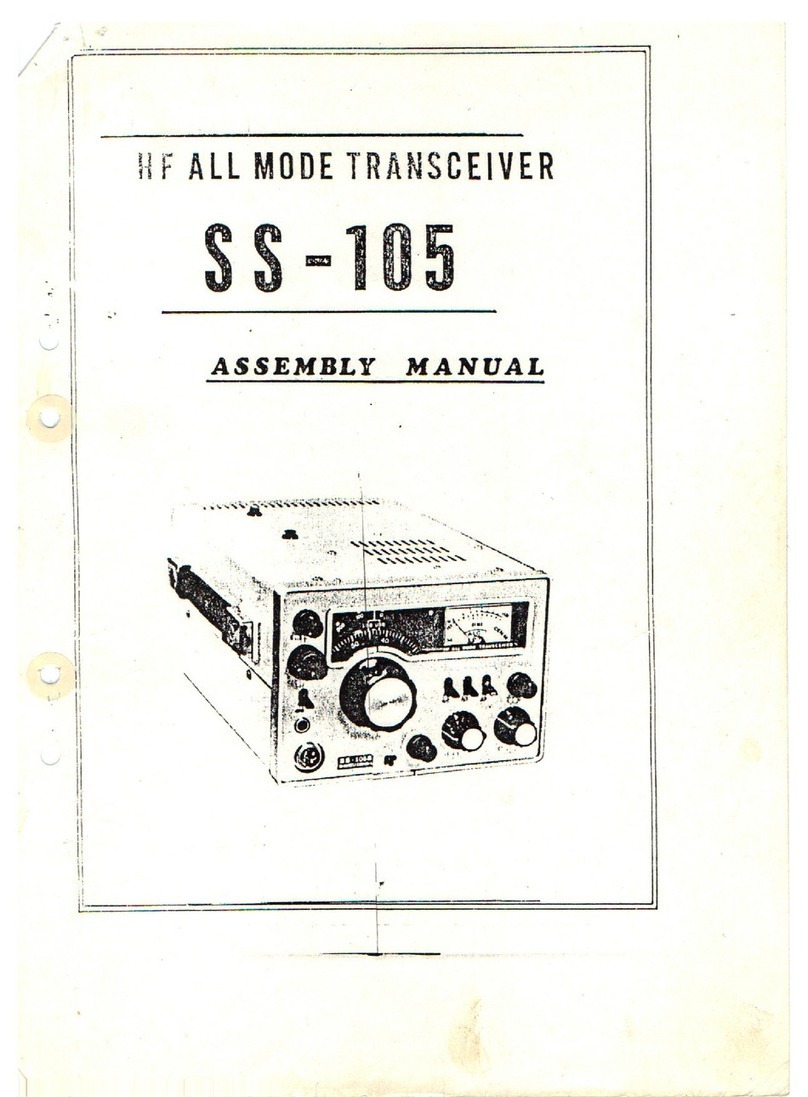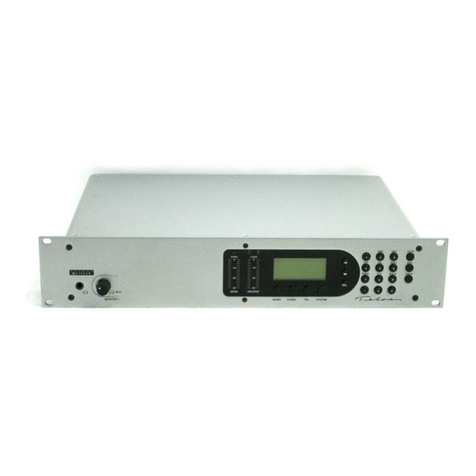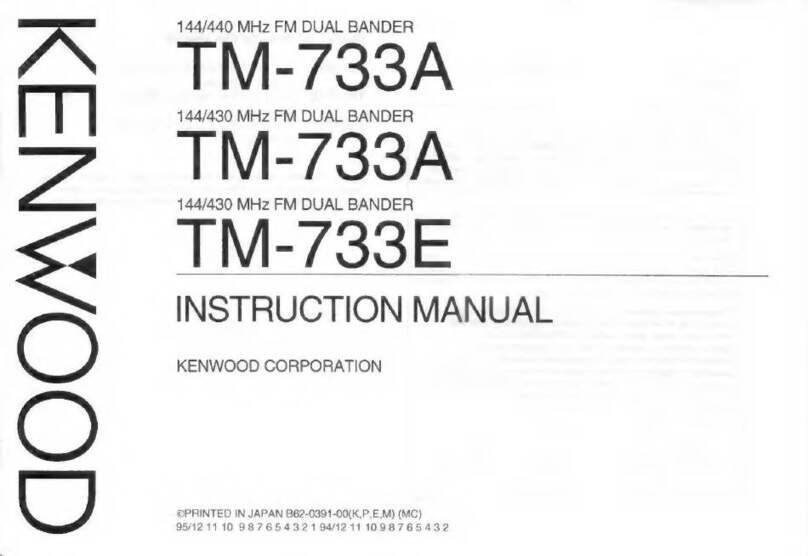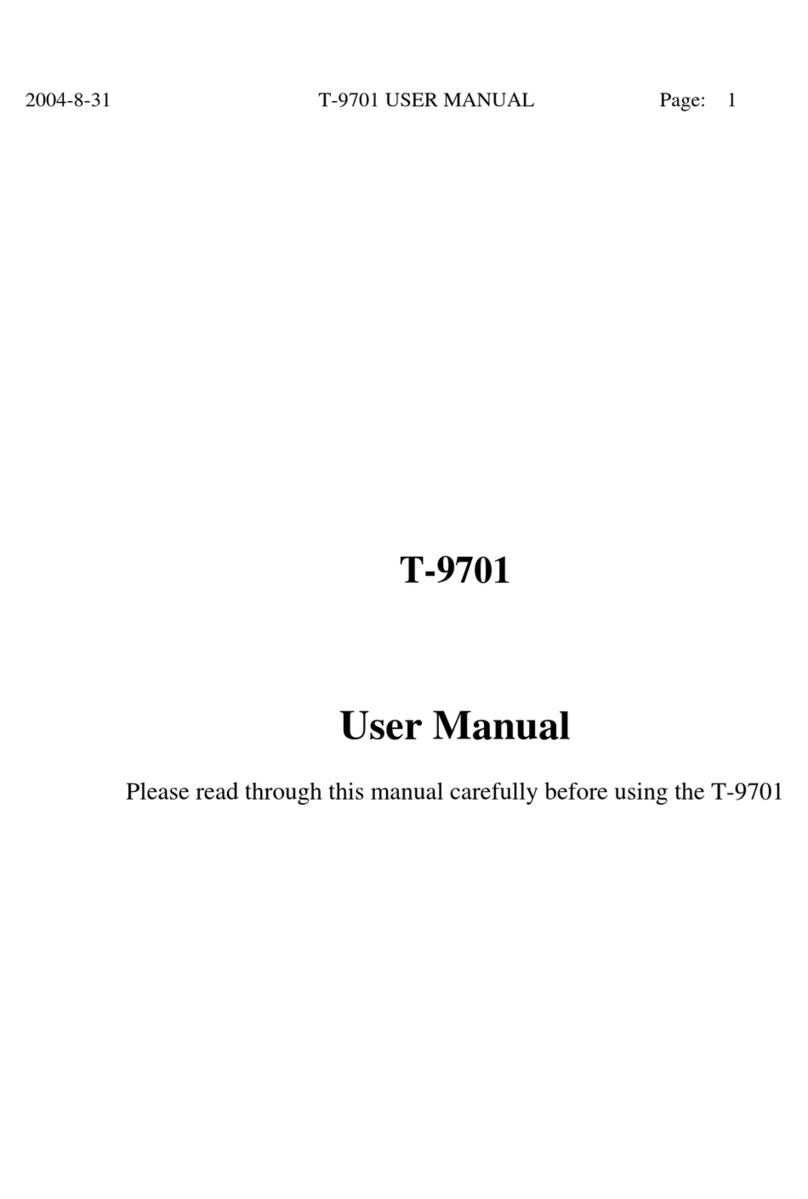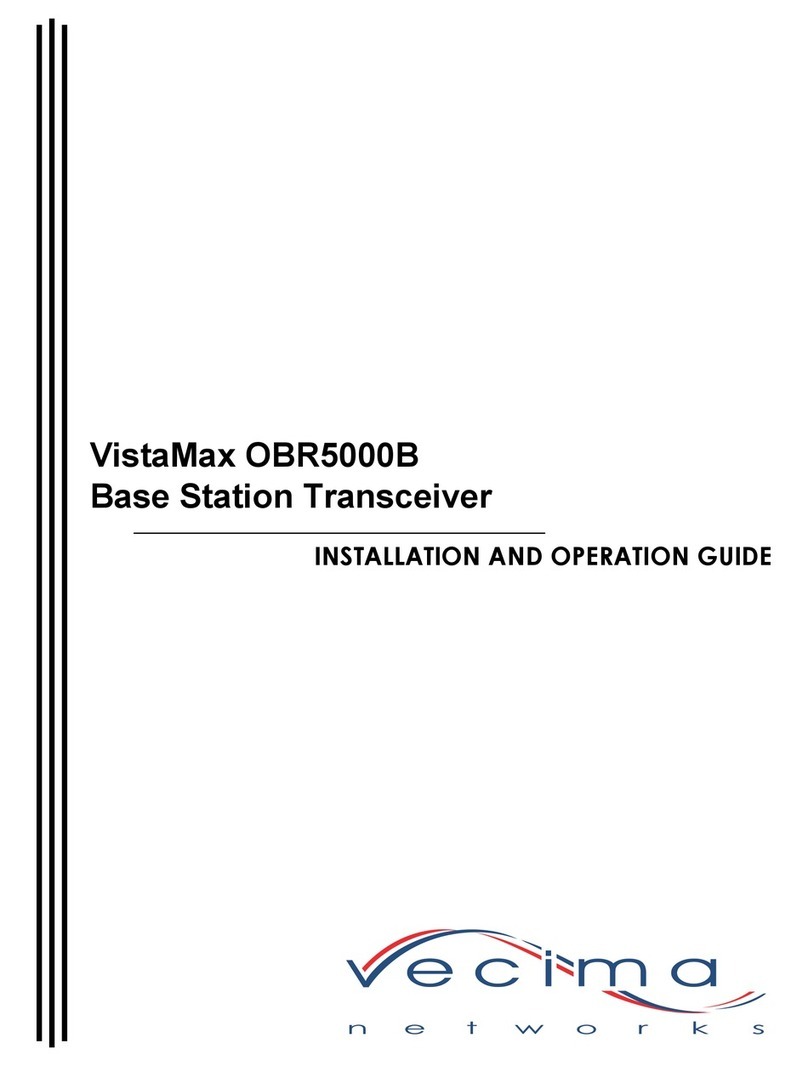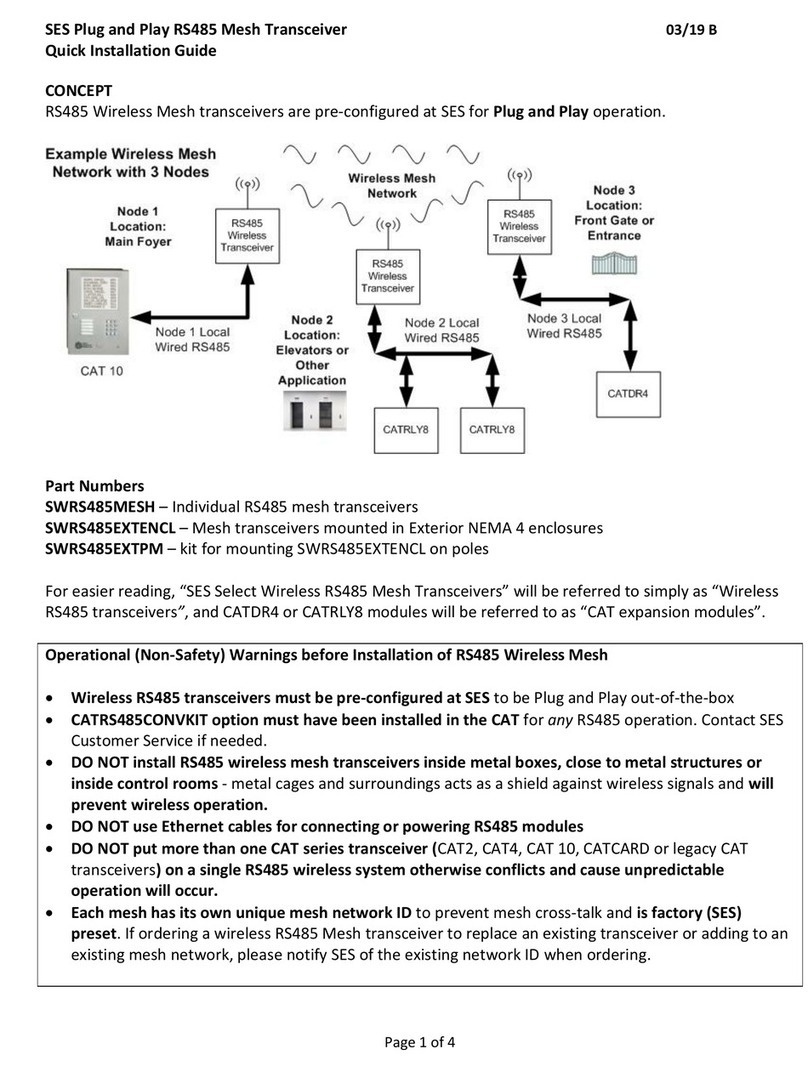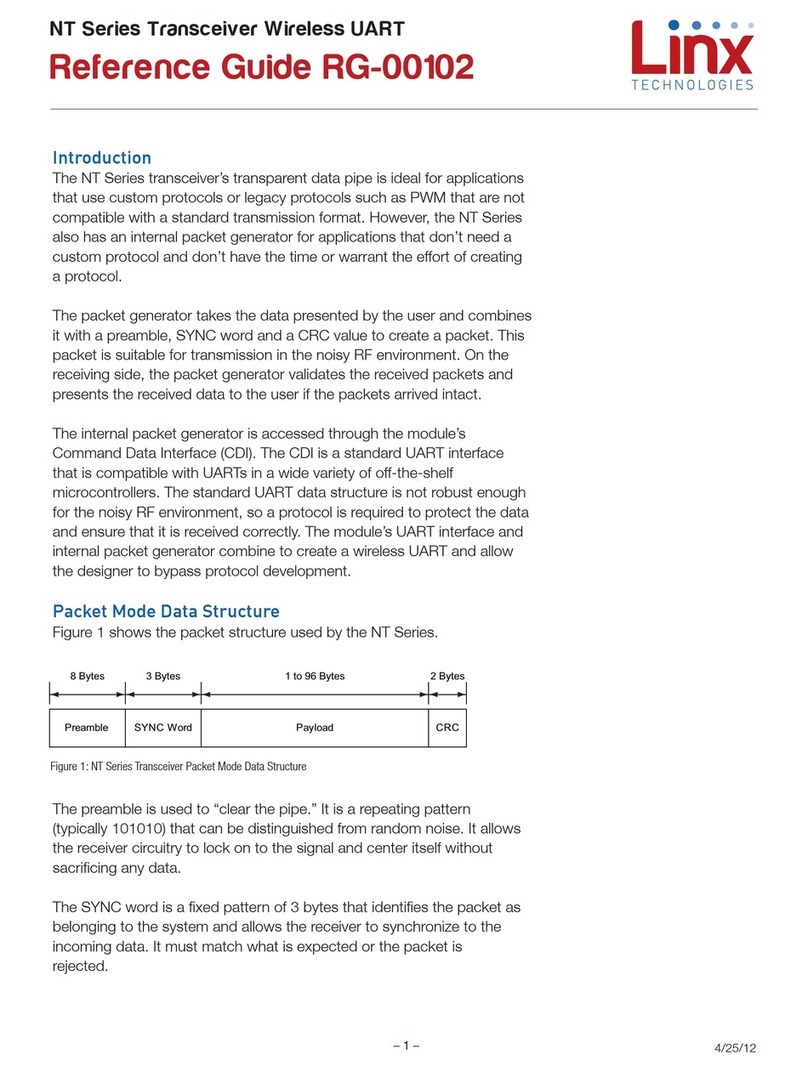SmartTrunk Systems ST-1000C User manual

ST-1000C (400Mhz ~ 470Mhz)
UHF FM COMPACT DIGITAL TRANSCEIVER
SERVICE MANUAL
SmarTrunk Systems, INC.
ST-1000C SM R1.1a

ST-1000C SM R 1.0 SMARTRUNK SYSTEMS, INC.
2
Table of Contents
1. Specifications: ............................................................................................................................. 4
2. ST-1000 EXPLODED VIEW............................................................................................................ 5
3. ST-1000 SIMPLIFIED DIAGRAM.................................................................................................... 6
4. - ST-1000 RF DESCRIPTION .............................................................................................................. 7
4.1. Circuit Configuration ............................................................................................................... 8
4.2. Receiver System ...................................................................................................................... 8
4.2.1. Front-end RF Receiver......................................................................................................... 8
4.2.2. ANALOG Audio Processing .................................................................................................. 8
4.2.3. Virtual Squelch Circuit ......................................................................................................... 8
4.2.4. Virtual VOLUME CONTROL .................................................................................................. 9
4.2.5. Sub audio signaling.............................................................................................................. 9
4.2.6. ANALOG AUDIBLE SIGNALING ............................................................................................. 9
4.2.7. DIGITAL AUDIO PROCESSING............................................................................................... 9
4.3. Transmitter System ............................................................................................................... 10
4.3.1. ANALOG TX SIGNAL........................................................................................................... 10
4.3.2. DIGITAL TX AUDIO:............................................................................................................ 10
4.3.3. Driver and Final Amplifier Stages ...................................................................................... 10
4.3.4. Automatic Transmit Power Control................................................................................... 11
5. RC-1000 ALIGNMENT ................................................................................................................ 12
5.1. Introduction .......................................................................................................................... 12
6. COMPLIMENTARY USER ALIGNMENT........................................................................................ 13
6.1. OPTION ALIGNMENT:............................................................................................................ 13
6.1.1. SQUELCH LEVEL:................................................................................................................ 13
6.1.2. ANNUNCIATION ................................................................................................................ 13
6.1.3. Tones................................................................................................................................. 14
6.1.4. Voice activated transmission............................................................................................. 14
6.1.4.1. VOX sensitivity level ...................................................................................................... 14

ST-1000C SM R 1.0 SMARTRUNK SYSTEMS, INC.
3
6.1.4.2. VOX inhibit on receive................................................................................................... 14
6.1.4.3. VOX delay ...................................................................................................................... 15
6.1.5. Battery save ...................................................................................................................... 15
6.1.6. Microphone sensitivity...................................................................................................... 15
7. ST-1000 SCHEMATIC ................................................................................................................. 17
11 ST-1000 COMPONENT LOCATOR................................................................................................... 18
11.1 ST-1000 TOP LAYER COMPONENTS LOCATION ......................................................................... 18
11.2 ST-1000 BOTTOM LAYER COMPONENTS LOCATION ................................................................. 19
12 ST-1000 PCB LAYOUT .................................................................................................................... 20
12.1 ST-1000 TOP LAYER PCB LAYOUT .............................................................................................. 20
12.2 ST-1000 BOTTOM LAYER PCB LAYOUT ...................................................................................... 21
12.3 ST-1000 PCB GROUND LAYER.................................................................................................... 22
12.4 ST-1000 PCB POWER LAYER ...................................................................................................... 23
13 ST-1000 BOM ................................................................................................................................ 24
14 ST-1000C MECHANICAL BOM........................................................................................................ 30
15 ACCESSORY PORT:......................................................................................................................... 32
16 ST-1000 SERVICE MANUAL REVISIONS.......................................................................................... 34

ST-1000C SM R 1.0 SMARTRUNK SYSTEMS, INC.
4
1. Specifications:
SPECIFICATION
ST-1000C
GENERAL
Frequency Range [Mhz]
400 TO 470
Channels
16
Power [Vdc]
6.4 to 8.8
Dimensions [mm]
120(H)x33(D)x57(W)
Weight [gr] (oz)
190 - (6.7)
Temperature range
- 30 °C ~ 60 °C (-22°F ~ +140°F)
Signaling
51 CTCSS tones / 183 DCS tones / 65533 SDR IDs
Display
No
Emergency call
No
GPS
No
Channel Scan
Yes
BCLO / BTLO
Yes
Power Saver control
Yes
TOT
Yes
Radio Kill/Alive
Yes
Adjustable Power Selection
H/L
Key lock
No
Password
Yes
Key Function selection
Yes
TRANSMIT
MAX RF power
2 W
Frequency Stability
>1PPM
Bandwidth [Khz]
12.5/25
Adjacent Channel Power
-65dBC (typ)
SNR
45dB typ
Analog harmonic distortion
5% typ (AF 1Khz, 60% deviation)
Data transmit rate
2400/4800bps
Max frequency deviation
Analog Modulation type
11K0F3E, 25K0F3E
FDMA Digital emissions
8K30F1E, 8K30F1D, 8K30F1W
Ext. Mic. Impedance
600 Ohms
RECEIVER
Analog Sensitivity
0.25uV (12dB Sinad)
Digital Sensitivity
0.3uV (5% BER)
Image rejection
60dB typ
Adjacent Channel selectivity
60dB typ @25KHz BW
HUM and NOISE ratio
40dB
Speaker Audio Power
1W
External audio power
1W
Specifications subject to change without notice or obligation

2. ST-1000 EXPLODED VIEW

3. ST-1000 SIMPLIFIED DIAGRAM
LPF
Ant Sw
D1/D4
Final
AMP
Q2
Power
Detection
D2
Driver
Q3
Buffer
AMP
Q1
TX CTRL
[U3]
CLOCK
[Y2]
POWER
CTRL
[U3]
FLASH
MEMORY
[U4]
RAM
MEMORY
[U7]
PWM
SIDE
KEYS
SERIAL
PORT
Main Processor
[U8]
Radio
U1
MIC
AMP
[U11]
AUDIO
PA
[U9]

Notes:

ST-1000C SM R 1.0 SMARTRUNK SYSTEMS, INC.
8
4. - ST-1000 RF DESCRIPTION
4.1. Circuit Configuration
The receiver is a single receiver
with built-in DSP fully integrated.
Incoming signals from the
antenna, after passing through
LPF filter, are fed direct to the DSP
down converter to get the
baseband voice from 0Hz to
3500Hz.
Demodulated signals are fed to the
DSP processor where are filtered
and conditioned. This processor
also includes a high efficiency FSK
modem.
For digital demodulation, once the
data is decoded, and free of errors,
it is fed into the into a vocoder
firmware module, which converts
the data to voice.
Analog voice from the analog path
or the analog voice recovered from
the vocoder firmware, are fed into
an audio power amplifier direct
from a digital to analog converter.
Transmit signal frequency is
generated by integrated VCO and
PLL. RF frequency generated by
the integrated RF chip is amplified
into a 3-step amplifier then filtered
by a low pass filter to be applied to
the antenna.
4.2. Receiver System
4.2.1. Front-end RF Receiver
Incoming RF signals from the
antenna are delivered to the
Receiver Unit and pass through a
Low-pass filter, antenna switching
diode, and then fed to the receiver
(U1) passing through a limiter
BPF.
4.2.2. ANALOG Audio Processing
The RF signal is tuned by U1,
which includes a base band DSP
audio processing, recovering flat
audio from DC up to 3500 hz.
The detected audio is amplified,
filtered and conditioned inside of
U8 which also includes a de-
emphasize filtering shape for
received audio signals by firmware.
The output of the filtered and
conditioned audio is delivered to
an audio power amplifier (U9) then
to the speaker passing through the
external audio connector switch.
4.2.3. Virtual Squelch Circuit
S/N ratio is measured by the
receiver (U1) as the result of the
analysis of the signal and the noise
of the carrier. The output is sent to
the main processor as a digital
frame, which is analyzed by radio
LPF
SWITCH
PROTECTION
FILTER
RECEIVER
[U1]
RECEIVER
[U1]
MAIN
PROCESSOR
[U8]
AMPLIFIER
[U9]

ST-1000C SM R 1.0 SMARTRUNK SYSTEMS, INC.
9
firmware, removing noise then
qualifying the signal level. If the
signal level is higher than the
expected for the current
programmed squelch threshold,
then the processor analyzes the
expected signaling programmed on
the current channel table.
In case of not any signaling is
required, or the signal has been
detected, the processor opens the
virtual audio path, unmuting the
audio amplifier (U9).
4.2.4. Virtual VOLUME CONTROL
The potentiometer position (RV1) is
measured by one analog to digital
converter on the main processor
(U8. The firmware immediately
adjusts the processor path gain to
get the appropriate overall circuitry
volume control.
Minimum volume, emergency and
private audio level are controlled
only by software overriding the
information received from the DAC
on U8.
4.2.5. Sub audio signaling
Received sub audio signaling as
CTCSS and DCS are received and
processed and detected by the
receiver (U1). Once decoded, the
sub audio signaling is reported to
the processor where the firmware
compares it with the value
programmed into the current
channel programming.
If the received signaling matches
the channel programming, then
the main processor (U8) opens the
audio patch.
4.2.6. ANALOG AUDIBLE SIGNALING
DTMF signals, MDC1200 and tone
signals are processed and decoded
by the main processor (U8).
Decoded information or received
tone is analyzed by firmware on
the main processor (U8).
4.2.7. DIGITAL AUDIO PROCESSING
Digital received information is
processed by the receiver DSP (U1)
then delivered to the main
processor (U8), which includes a
very sensitive FSK modem.
Data decoded by the modem
firmware is transferred to the main
code, which de-encrypts the
information, checks the integrity,
corrects the wrong bits and extract
the audio information form the
received frame.
The portion of the data received,
error free, is moved to the vocoder
firmware module internally into
the main processor (U8).
The vocoder firmware re-builds the
audio from the compressed data
then applies filter it, adjust the
volume and fed it to the audio
power amplifier (U10) through one
RECEIVER
[U1]
AMPLIFIER
[U10]
MAIN
PROCESSOR
[U8]
VOCODER
U6]

ST-1000C SM R 1.0 SMARTRUNK SYSTEMS, INC.
10
high definition digital to analog
converter.
4.3. Transmitter System
4.3.1. ANALOG TX SIGNAL
The AF signal from the internal
microphone (MK1) or external
microphone (J4) are processed as
differential signal, then it is
conditioned and transformed into
common mode by the microphone
pre-amplifier (U11).
The result of the conditioned in-
band filtered signal is fed to the
Main Processor (U8), which
provides audio gain control,
compander, emphasize, limitation,
encryption, etc. by software
algorithms.
The high audio band of the signals
from 300 to 3500 Hz are directly
fed to the transmitter (U1), which
performs a direct modulation of a
generated carrier.
Low frequency signaling audio is
fed directly to Y1 VC TXCO main
clock generator and U1 with a
corresponding balance controlled
by software.
4.3.2. DIGITAL TX AUDIO:
The AF signal from the internal
microphone (MK1) or external
microphone (J4) are fed directly to
the main processor (U8), which
perform the signal filtering, the
data codification, into especial
firmware block. The result of the
digitized information is processed
by a FEC (Frame Error Correction)
module, adding spare bits to
ensure high robustness to the
data, then it is encrypted and the
user related information as user ID
is added.
The final data frame is fed to the
modem code, which generates the
FDMA signals, controlling the
modulation of the Transmitter (U1)
through the VC TXCO for DC to
low frequencies and the direct
modulation for higher frequencies.
4.3.3. Driver and Final Amplifier Stages
Final RF is amplified on Q1
(2SC3356) then filtered to be fed to
Q3 (2SK3475) then finally
amplified by Q2 (2SK3476) up to 2
watts output power.
The transmit signal then passes
through the antenna switch D1
(BAR88) and is low-pass filtered to
suppress harmonic spurious
radiation before delivery to the
antenna.
AMPLIFIER
[U11]
MAIN
PROCESSOR
[U8]
TRANSMITTER
[U1]
VC TXCO
[Y1]
TRANSMITTER
[U1]
VC TXCO
[Y1]
MAIN
PROCESSOR
[U8]
AMPLIFIER
[U11]

ST-1000C SM R 1.0 SMARTRUNK SYSTEMS, INC.
11
4.3.4. Automatic Transmit Power
Control
The RF power detector (BAS70)
detects transmitted feedback then
sends the readout to audio
processor U8. The special firmware
module compares the transmitted
power against the referred level
stored on current channel memory
adjusting the power control level
generated as reference by one DAC
output on the same processor (U8)
then amplified by U3 (MCP6241U)
controlling the gate current on Q1
and Q17.
Notes:

ST-1000C SM R 1.0 SMARTRUNK SYSTEMS, INC.
12
5. RC-1000 ALIGNMENT
5.1. Introduction
The ST-1000 series is carefully
aligned in factory for the specified
performance, across the frequency
range depending for each version.
As the core of the radio is firmware
only, all processes are the result of
the internal feed-back where
alignment by user is not required.

ST-1000C SM R 1.0 SMARTRUNK SYSTEMS, INC.
13
6. COMPLIMENTARY USER ALIGNMENT
Additional complimentary
parameters should be also aligned
on user login mode; it means the
user can align it as per the most
convenient way for particular radio
usage.
6.1. OPTION ALIGNMENT:
To access to the option alignment
menu, select Edit then Options
form the main software toolbar:
As soon as you click on Options…
the Options screen is popped up:
From this screen the user can
adjust some parameters as:
6.1.1. SQUELCH LEVEL:
ST-1000 supports a dBm scaled
squelch adjustment.
To set a desired squelch reference,
please select you desired squelch
level form the list:
Press [OK] to store it in the file.
The value will be updated after the
file is transferred to the radio.
6.1.2. ANNUNCIATION
You can enable or disable voice
annunciation.
To enable it, please check the
Voice box into the Options
alignment screen:

ST-1000C SM R 1.0 SMARTRUNK SYSTEMS, INC.
14
6.1.3. Tones
You can enable or disable tones
generation when a key is pressed.
To enable it, please check the
Tones box into the Options
alignment screen:
6.1.4. Voice activated transmission
You can enable or disable the VOX
functionality for your radio.
To activate this feature, please
check the VOX-Enabled Box.
Once you check it, some additional
VOX control parameters are
enabled:
6.1.4.1. VOX sensitivity level
To adjust the VOX sensitivity level,
please press on the down-arrow of
the scroll-down box on the right
side of the Level label, and then
select the desired value. Low
values means less sensitivity (noisy
environments)
6.1.4.2. VOX inhibit on receive
In case you do not use
headphones, the audio received on
the speaker can be captured by the
microphone, setting the radio on
transmit mode. To avoid this issue,
you can automatically disable the
VOX feature when the radio is
receiving voice.
To enable this feature, check the
Vox Inhibit On Receive box:

ST-1000C SM R 1.0 SMARTRUNK SYSTEMS, INC.
15
6.1.4.3. VOX delay
It is very common that when you
use VOX services in the radios, the
first words cannot be transmitted
because the voice detection and
the transmit power warm-up takes
time, losing part of the message.
SmarTrunk VOX delay can be
activated to avoid this issue.
When active Vox Delay service, the
radio is recording any audio
captured by the microphone and it
is real time analyzed by the
processor. In case audio is
detected, the radio sets on TX
mode, playing back the pre-
recorded audio after a delay to
ensure the receiver is already
getting the incoming voice. On this
way, no word is missed on the air.
To activate this feature, please
check the Vox Delay box:
6.1.5. Battery save
If the radio is not active on any
conversation, it is not necessary
that all radios internal
functionalities remain active.
To save battery by disabling some
radio functionalities temporary
when the radio is not involved on
any conversation, please check the
Battery Save box:
6.1.6. Microphone sensitivity
Depending how noisy the
environment is, or how sensitive is
the external microphone in use,
the microphone sensitivity must be
adjusted as per user comfort.
Please use the drop down list on
the right side of Mic Sensibility
label to select the desired
microphone sensitivity gain.

ST-1000C SM R 1.0 SMARTRUNK SYSTEMS, INC.
16
Press OK to store your changes
into the radio file. The information
will be updated to the radio once
you transfer the file.

7. ST-1000C SCHEMATIC
Title
Size Document Number Rev
Date: Sheet of
DM-140224-01 D
ST-1000 R1.2
C
1 1Tuesday, October 07, 2014
GPSE
C65
NC
L15
13nHD4
BAR63
TST4
1
1
C57
47pF
L16
NC
R53 330
L14
0
D3
HSM88AS
3
1
2
C56
0
C64
NC
RXD
C55
0
TXD
CHA
R54 330
SCR
CHD
R58 1K
C72
1nF
PTUN
CSFM
C192
1nF
t
RT1
33tk
1 2
C77 100nF
C137
100nF
R24
1K
U5
AT23DF321
CS
1
SO
2
WP
3
GND
4SI 5
SCK 6
HOLD 7
VCC 8
L11
0
3VD
C167 NC
CHC
C142
NC
MEMORIES
3VD
C46
NC
MISO
MOSI
SCK
C34
33pF
3VD
PTTI
C35
56pF
U7
23K640
CS
1
SO
2
WP
3
GND
4SI 5
SCK 6
HOLD 7
VCC 8
C119 10nF
SCK
MISO
R15
150
MOSI
C19
1nF
Q2
2SK34761
32
C37
15pF
DPOW
C47
15pF
BIAS
R12
47
C15 100nF
C16 150pF
TST5
1
1
R8
10K
R5
10K
R85 1K
R6
47K
LRX
MIC
CHC
L5
27nH
BAT
L2
BEAD
12
+7V
C9
1nF
R78 470
C13
150pF
R101
47K C159
NC
R50
NC
C4
150pF +
C5
106
3VD
R94 10K
C38
27pF
LCB1608-600
C160
1nF
L7
0
R79 1k
R21
100
C66
150pF
C156 1uF
C48
.5pF
D2
BAS70
+
C161 4.7uF
R23
100K
R82 1K
SW3
SW KEY-Y M061
12
3 4
C40
.5pF
R20
100
SW1
SW KEY-Y M061
12
3 4
C20
470pF
C155
NC
TP1
1
C82 1nF
TP2
1
R88 10K
TX5V
R2
100
TP3
1
C6
10nF
C88 NC
TP9
1
SW2
SW KEY-Y M061
12
3 4
L4
.82uH
TP7
1
TP8
1
R103 1K
MICROPHONE
BAT
TP6
1
TP4
1
TP5
1
C10
1nF
R106
1K
R81
150K
TST1
1
1
R105
2K2
D1
BAR63
C29
10pF
R80
100
R102
100K
CSRM
C162
1nF
SIDE UP
C163
1nF
SIDE DOWN PTT
C83 1nF
MK1
MIC
1
2
C154 1uF
C173 1nF
R83
1K
3VD
U11
MCP6241U
Vin+ 1
VSS 2
Vin- 3
Vout
4VDD
5
C158
10uF
R45 1K
R112
10K
TST6
1
1
C107 1nF
MIC
AFO
C126
10nF
C78 1nF
C89 NC
LTX
RON
C71
100nF
3VD
C63
100nF
R48
NC
C73
2.2uF
C104 NC
R26
22KC74
NC
R25
100K
C39
NC
DISC
SPM
C61
100nF
P2
ANT
1
1
R39 1K
R57 1K
C62
1nF
C84 1nF
C51
NC
TXDG
C49
100nF
C50
1nF
C164
1nF
TXDG
R96 1K
L12
15nH
C52
NC
TP10
1
C191 NC
C23
7pF
MODD
C53
NC R17
560
R11
2K2
Q1
2SC3356
3
21
C94 NC
R18
22
C54
150pF
C17
10nF
MODD
L3
27nH
3VD
R10
470
C14
150pF
R4
22
C133 1nF
TX5V
C24
22p
GPSE
TMP
C32
15pF
L13
15nH
C45
NC
C79 NC
C58
1uF
R13
47 R14
47K C8
10nF
C7
150pF
R33
4K7
R7
22K
RSCK
RADIO CLOCK
Q3
2SK34751
32
C170 1nF
Y2
VC-TXCO
12
3 4C114
1nF
+
C76
22uF
L6
27nH
PWFB
C18
150pF
3VR
R27
100
+7V
L1
BEAD
12
C214 1nF
RCLK
+
C120
10uF
C3
10nF
C2
1nF
R86 1K
3VR 3VR
IRQR
+C60
106
C85 1nF
5
C28
15pF
C22
100pF
+
C75
22uF
TX POWER SUPPLY
CHD
U2
HT7250
Vin
1
GND
2
Sht
3
Vout 5
BP 4
TX5V
C115
10nF
R30
10
+7V
+
C121
10uF
MISO
RSCK
RCLK
C122
1nF
PTTI
+C116
10uF
C143
100nF
C117
10nF
U1
RDA1846
AVDD1
1
SCK
2
MOSI
3
AVDD2
4
XTAL1
5
XTAL2
6
MODE
7
CSR
8
AFO
9
NC1
10
MIC
11
CC
12
AVDD3
13
NC2
14
RFIN
15
AVDD4
16
NC3 17
RFOUT 18
NC4 19
NC5 20
AVDD5 21
PABIAS 22
AVDD6 23
PDN 24
IO7 25
IO6 26
IO5 27
IO4 28
MISO 29
INT 30
SUBD 31
SUB 32
GND 33
C69
100nF
R89 1K
C70
1nF
+7V
R60 1K
C68
1nF
C67
1nF
C12
1nF
C11
100nF
RDIO
VOL
R16
2M2
C21
150pF
C43
5pF
C27
2pF
C44
6.8pF
L10
13nH
C42
10pF
AFO
C86 1nF
L9
13nH
R74 47
C26
2.4pF
L8
13nH
C41
5pF
C25
NC
+
C131
10uF
IRQG
R47
470
C105 10K
EMIC
R87 1K
TXD
C81 1nF
C109
100nF
CSRM
R65 1K
U8
ATSAM4S8BA
ADVR
1
GND1
2
AD4
3
AD5
4
AD6
5
AD7
6
VDDIN
7
VDDOUT
8
AD0
9
AD1
10
AD8
11
VDDCORE
12
AD2
13
AD9
14
PA23
15
AD3
16
GND2
17
VDDIO1
18
PA16
19
PA15
20
SCK
21
MOSI
22
PA24
23
VDDCORE1
24
PA25
25
PA26
26
MISO
27
CS0
28
UTXD
29
URXD
30
PA8
31
PA9
32
PB4 33
TXD0 34
RXD0 35
PA4 36
PA27 37
PA28 38
NRST 39
TST 40
PA29 41
CS2 42
CS3 43
PA2 44
VDDIO2 45
GND3 46
PWM1 47
PWM0 48
PB5 49
JTAGSEL 50
PB6 51
CS1 52
PB7 53
PB12 55
VDDCORE2 54
USBM 56
USBP 57
VDDIO3 58
DAC0 59
GND4 60
XOUT 61
XIN 62
DAC1 63
VDDPLL 64
CSRM
SPM
C108 1nF
MIC-2954-03WS
MIC-2954-03WS
RDA POWER SUPPLY
CHA
U15
RT9163
VIN
3VOUT 1
GND
2
+5V 3VR
RDIO
+
C194
106
C204
10nF
RSCK
U13
HT7233
Vin
1
GND
2
Sht
3
Vout 5
BP 4
R49
10K
3VD
+
C195 4.7uF
R108
10
C134
NC
PROCESSOR POWER SUPPLYAUDIO POWER SUPPLYMAIN POWER SUPPLY +5V
+7V
+
C198
1uF
R107
0
C201 1nF
U12
RT9163
VIN
3VOUT 1
GND
2
+
C196
10uF
+7V
R110
2.2
C203 1nF
C197
NC
C202
10nF
+5V
3VD
RON
RXDG
R115
100
C209 1uF
C205
10nF
+
C206 10uF
R72 1K C152 470p
U14
HT7233
Vin
1
GND
2
Sht
3
Vout 5
BP 4
C208 1nF
C1
1nF
RXD
R109
0
C207
10nF
C130 1nF
+
C199
1uF
AFO
R64 1K MUTE
SSW
5VAF
+
C200
10uF
R99 47
DISC
C175 1nF
C111 1nF
C174 1K
3VD
LTX
BIAS
R84
NC
C189 NC
C30
NC
C59
NC
CSFM
C213
1nF
MIC
3VD
5VAF
PTTI
AFO
SSW
R59 1K
SmarTrunk Systems, INC
PCTRL
C168 NC
R63 1K
J4
3.5mm
3
5
4
2
1
TMP
MODD
R3
1K
BAT
DISC
R1
1K
TMP
R51
NC
References:
Pink components not loaded on ST-1000
R35
47K
R34
2K2
C124
10nF
POWER CONTROL
TX5V
EMIC
U3
MCP6241U
Vin+
1
VSS
2
Vin-
3Vout 4
VDD 5
R36 82K
SCR
R31
470K
C113
10nF
R28
56K
MIC
C99
10nF
R93 1K
PCTRL
TX5V
C188 NC
R38
1K
R32
56K
C100
10nF
TX5V
R71 1K
R37
47KC125
220nF
R116
100
R95 1K
U4
PEB-916
ANT
1
AGND1
2
AGND2
3
AGND3
4
VBAT
5
GND1
6
NC
7
AGND4
8
AGND5
9
AGND6
10
VCC
11
AGND7 12
NRES 13
AGND8 14
GND2 15
NC 16
AGND9 17
NC 18
AGND10 19
1PPS 20
AGND11 21
AGND12 22
AGND13 23
GND 24
NC 25
AGND14 26
NC 27
AGND15 28
AGND16 29
TX0
30
RX1
31
NC
32
GND
33
NC
34
AGND17
35
AGND18
36
C110 NC
MODD
R22 10K
IRQR
CHB
R29
4K7
C177 10uF
C123
1nF
DPOW
+5V
+
C136
10uF
C139
10nF
R43
10
U6
HT7233
Vin
1
GND
2
Sht
3
Vout 5
BP 4
C140
100nF
C141
1nF
R44 1K
3VD
C128
8PF
L17
ANT
R66 22k
R55 1K
LRX
R62 1K
C178 1uF
R92 1K
PTUN
CSFM
C187 NC
C179 1uF
CSG
SCK
CHA
PWFB
IRQR C148 10nF
C171 NC
C169 NC
F1
C2Q 3
J6
CON4
1
2
3
4
C180 100nF
L18
BLM18K121
C176 1nF
J5
TG-2915
5
4
3
2
1
C193
1nF
C210
1nF
TST2
1
1
C106 22K
RV1
10k
3 1
24
5
3VD
3VD
C212
10nF
+7V LCB1608-600
3VD
SCR
LRX
BATTERY
D5
LTST-C195KGJRKT
2 4
1 3
LTX
LEDS
R52
10K
R111
100K
C181 100nF
EMIC
R113
33K
RDIO
GPSE
TXD
R97 1K
PTUN
J2
ROTARY
3
4
5
6
7
82
1
C95
1nF
C96
1nF
C97
1nF
C98
1nF
CHB
C172 NC
C182 1uF
R98 47
C138
10nF
SPM
R56 1K
C165
NC
IRQG
U9
BH7824
CTLR
1
B_OUT
2
B_IN
3
SP_IN
4SP1 5
VCC 6
GND 7
SP2 8
3VD
TST3
1
1
C144
10nF C146
1uF
C145
100nF
C183 1uF
C190 NC
R67
10K R69 100K
5VAF
C151 2.2uF
R100 47
C147 1nF
C149
1uF
MUTE
R117
470
R91
22K
C150 100pF
C129 NC
R90 1K
C211
1nF
AUDIO PA
LS1
SPEAKER
VOL
C153 1uF
MOSI
C80 1nF
C184 100nF
SSW
R61 4K7
R77 1K SPM R76
1K
RXDG
CHB
CHC
C101 NC
C166 NC
R70 1K
C185 100nF
C186 NC
U10
LIS302
VDDIO
1
GND
2
VDD
3
GND
4
GND
5
VDD
6
CS
7INT1 8
INT2 9
GND 10
GND 11
MISO 12
MOSI 13
SCK 14 SCK
MOSI
MISO
3VD
R68 1K
C157
100nF
CSG
SPM
CHD
R104 1K
MUTE

11 ST-1000C COMPONENT LOCATOR
11.1 ST-1000C TOP LAYER COMPONENTS LOCATION

ST-1000C SM R 1.0 SMARTRUNK SYSTEMS, INC.
19
11.2 ST-1000C BOTTOM LAYER COMPONENTS LOCATION

ST-1000C SM R 1.0 SMARTRUNK SYSTEMS, INC.
20
12 ST-1000C PCB LAYOUT
12.1 ST-1000C TOP LAYER PCB LAYOUT
Table of contents
Other SmartTrunk Systems Transceiver manuals
